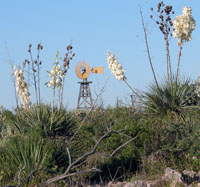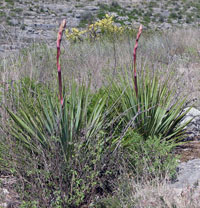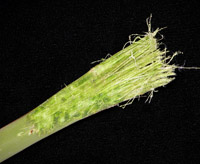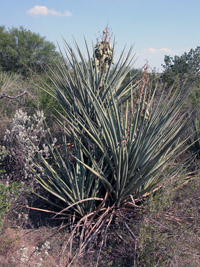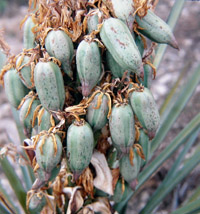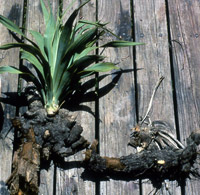Yucca [Yucca spp.]
Two types of yucca plants grow in the Plateaus and Canyonlands region, thick-leaved (or fleshy) yuccas and thin-leaved yuccas. There are several species of each type in or near the region. The leaves of all of the region’s yuccas have strong fibers suitable for weaving and other uses, and the stems of most species can be used for soap. Yucca flowers and flower stalks are edible. The thick-leaved yuccas have edible fruits. Like the agaves, the yuccas store carbohydrates in their stems and leaf bases, but we lack convincing evidence that yucca stems were baked in earth ovens and eaten in a similar fashion as lechuguilla and sotol. Based on current knowledge, yuccas were at least a minor food source in the region and an important source of weaving and sewing materials as well as soapy compounds.
Details
There are three species of thin-leaved yuccas growing in the area: Buckley’s yucca (Yucca constricta), narrow-leaf yucca (Yucca reverchonii), and Thompson’s yucca (Yucca thompsonii). They produce a dry, inedible fruit, but the leaves can be used for weaving and the stems for soap.
Edible yucca fruits come from the fleshy-leaved yuccas. The best documented of these is the banana yucca, Yucca baccata. Its distribution is centered west of the Edwards Plateau in the Sonoran and Chihuahuan Deserts. Although banana yucca specimens have been collected from extreme northwestern Val Verde County, the most common of the edible yuccas in the study area is Torrey yucca, Yucca torreyi. Although to the uninitiated the Torrey yucca vaguely resembles the banana yucca, the fruits are about one-half the size of the robust banana yucca fruit.
We don’t have any ethnographic accounts of the use of Torrey yucca, but there are many references to the use of banana yucca are applicable to the Torrey yucca. For example, because so many animals consume the fruit, several Native American groups harvested the fruits before they ripened. They ripened the fruits by burying them under a mound of earth or soaking it in water (Gifford 1932). Often the fruit was heated in a fire before soaking it in water. When ripe, the fruit is slow-roasted or cooked in a small earth oven; the resulting product is brown and sweet, much like molasses or figs. Banana yucca is somewhat sweeter than the Torrey yucca. The seeds are stripped from the fruit and the flesh is either eaten immediately, or sun-dried, or pounded into a powder that may be stored and mixed into other foods. Some groups, like the Gila Pima, boiled the fruit, dried it, and pounded into a sweet meal (Russell 1908). Yucca fruit are not only sweet, they are, like agaves, a very strong laxative (Palmer 1871).
Thick and thin-leaved yucca flowers and flower stalks are edible. The flower stalks of the narrow-leaf yucca (Yucca reverchonii), are edible raw, but it's best to eat the portion just below the leaf-like bracts, because they can be a little spiny. Yucca flowers were eaten, as evidenced by the abundant pollen recovered from some coprolites (Williams-Dean 1978).
Like the agaves, the yuccas store carbohydrates linked to steroids in a class of chemicals called saponins. When the central stems or rhizomes of some yuccas are pounded and soaked in water, the resultant mix will foam. Of all the yuccas growing around Hinds Cave, Torrey yucca provides the best source of this natural detergent.
Torrey yucca leaves contain a long straight fiber that is much finer than the Agave lechuguilla fiber, and provided material for baskets, fine cordage, and perhaps even the paintbrushes that were used to paint the murals on the canyon walls. The entire leaf of the thin-leaved yuccas has been used to weave mats in a manner similar to the mats woven with sotol leaves.
References
Gifford, E.
1932 The Southeastern Yavapai. University of California
Publications in American Archaeology and Ethnography. 29(3):177-252.
Palmer, E.
1871 Food Plants of the North American Indians. USDA
Report to the Commissioner of Agriculture for 1870. U.S. Government Printing
Office, Washington, D.C.
Russel, Frank
1908 The Pima Indians. US Bureau of American Ethnology,
26th Annual Report. 17-389.
Williams-Dean, Glenna
1978 Ethnobotany and Cultural Ecology of Prehistoric
Man in Southwest Texas. Anthropology Research Laboratory, Texas
A&M University,
College Station.
Hide Details
![]()
